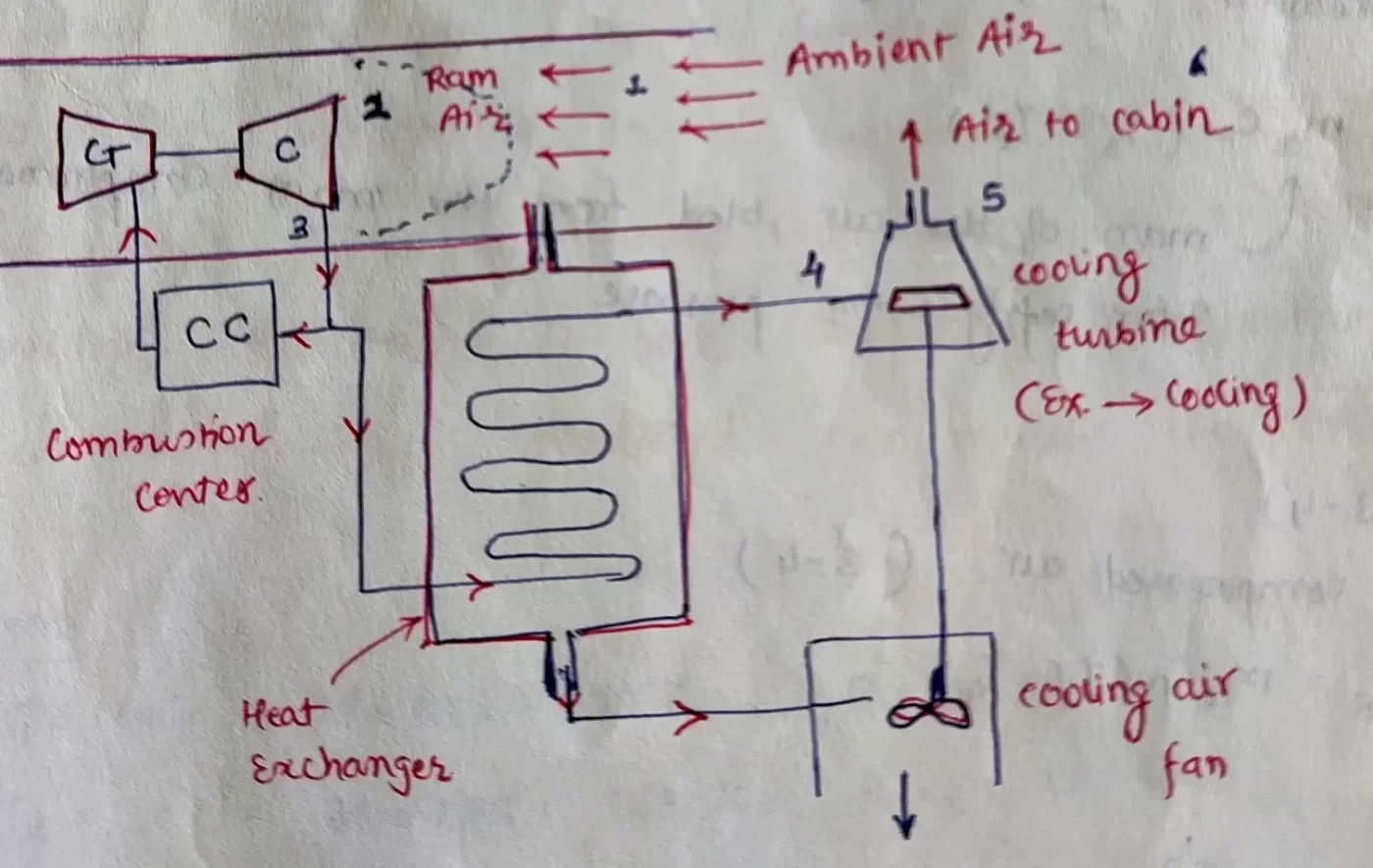Can you imagine the aircraft comfort conditions at a height of 30,000 to 40,000 feet? Because the ambient temperature is of the order of -20 degrees C approximately and pressure of the order of 0.3 bar approximately. Now, imagine persons or passengers traveling in airplanes would be at risk or they will not be in comfortable conditions at all. so, This article highlights the importance of airplane refrigeration.
Not only low temperature and pressure at the height of 30000 feet but also some other cooling loads need to be removed during the operation of the airplane.
Table of Contents
Aircraft comfort: External heat sources in airplane
Various external heat sources in airplanes add heat to the airplane cabin and this affects the aircraft comfort. These are solar radiation coming from the sun directly without the resistance of air at such high altitudes. These radiations are extreme in magnitude compared to what Earth receives. Thus, it increases the heat in the cabin. Additionally, the frictional heating caused by air resistance or drag further compounds the issue, particularly during high-speed flight or maneuvers.

The inside pressure of the cabin would be very low if we fed the ambient air directly into the cabin. Thus, we need to compress the air that enters the cabin and thus increase the temperature level. This extra sensible heat needs to be removed during the refrigeration process. The high speed of the aircraft also produces heavy skin friction with the surface of the airplane and air and that adds sensible heat into the cabin. We must remove this heat to give aircraft comfort to all the passengers and crew.
Aircraft comfort: Internal heat sources in airplane
Along with external heat sources, internal heat sources also add heat to the airplane atmosphere making aircraft comfort worse. These are heat liberated by the passengers during their journey and heat liberated by foods and beverages sold or served on the journey. Also, the heat produced by electric or electronic devices/avionics for control and comfort is a source of heat. The engine heat also needs to be included in the heat source list. All heat needs to be removed during the refrigeration process for an airplane.
In this environment, the absence of adequate refrigeration and AC systems would not only result in discomfort but also pose serious health risks to passengers. Very long-time exposure to high temperatures can lead to dehydration, heat exhaustion, and even heatstroke, jeopardizing both passenger safety and flight operations.
Also, efficient thermal management is crucial for preserving sensitive electronic equipment and maintaining to optimal performance. Without proper cooling mechanisms, the risk of equipment malfunction or failure increases, compromising the aircraft’s navigational and communication systems.
Thus, it is very important to have a refrigeration system that has a low energy requirement compared to a vapor compression refrigeration system for the same heat load. The aircraft refrigeration system does this task.
Conclusion:
Thus, In conclusion, refrigeration and air conditioning systems or aircraft comfort serve as indispensable guardians of comfort, safety, and operational integrity. By mitigating the impact of external and internal heat sources, these systems ensure a conducive environment for passengers and crew giving secure and safe journeys.
FAQs on Aircraft Comfort:
- Why is refrigeration or air conditioning necessary for aircraft comfort?
- Refrigeration and air conditioning systems are essential in aircraft to regulate cabin temperature, ensuring passenger comfort and safety, especially during flights at high altitudes where external temperatures can be extreme.
- What are the main external heat sources that affect aircraft temperature?
- External heat sources in aircraft include solar radiation, atmospheric friction, and ambient air temperature variations, all of which can significantly impact cabin temperature if not adequately managed.
- What internal heat sources contribute to the overall thermal load for aircraft comfort?
- Internal heat sources in airplanes encompass engine heat, heat generated by avionics systems and electronic equipment, as well as body heat emitted by passengers and crew members, all of which can elevate cabin temperatures.
- How does inadequate cabin cooling affect passenger health and safety?
- Insufficient cooling in the cabin can lead to discomfort, dehydration, heat exhaustion, and even heatstroke among passengers and crew, posing serious health risks and potentially compromising flight safety.
- What role do refrigeration and air conditioning systems play in preserving sensitive aircraft equipment?
- Refrigeration and air conditioning systems help maintain optimal operating temperatures for critical aircraft systems, including avionics, navigational equipment, and communication systems, reducing the risk of equipment malfunction or failure.
- How do aircraft HVAC systems differ from those used in buildings or other environments?
- Aircraft HVAC systems are designed to operate efficiently in the unique conditions of an aircraft, where space, weight, and power constraints are significant factors, requiring specialized engineering and technology.
- What measures are in place to ensure the reliability of refrigeration and air conditioning systems during flight?
- Aircraft refrigeration and air conditioning systems undergo rigorous testing and maintenance to ensure their reliability and performance, with redundant systems often in place to provide backup in case of failure.
- Are there any environmental considerations regarding aircraft refrigeration and air conditioning systems?
- Aircraft manufacturers and operators strive to minimize the environmental impact of refrigeration and air conditioning systems by employing energy-efficient technologies and adhering to regulatory standards for emissions and refrigerant usage.
- How do pilots and flight crew interact with aircraft refrigeration and air conditioning systems during flight?
- Pilots and flight crew monitor and adjust cabin temperature settings as necessary to maintain a comfortable environment for passengers, relying on instrumentation and control panels integrated into the aircraft’s cockpit.
- What advancements are being made in aircraft refrigeration and air conditioning technology?
- Ongoing research and development efforts focus on improving the efficiency, reliability, and environmental sustainability of aircraft refrigeration and air conditioning systems, with innovations such as advanced cooling materials, predictive maintenance algorithms, and alternative refrigerants.

